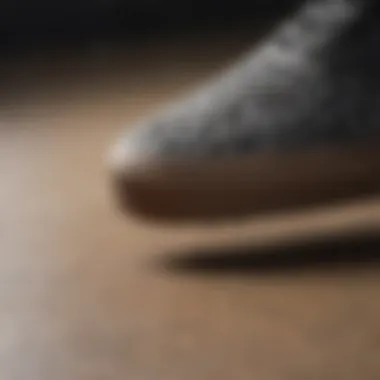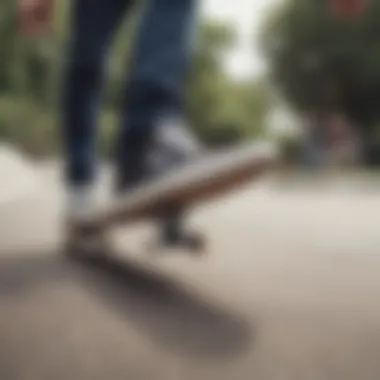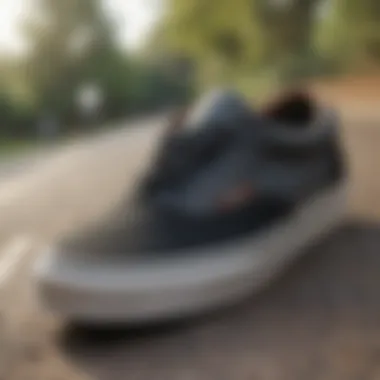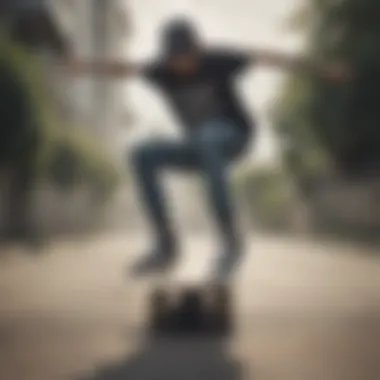Assessing Vans: Are They the Best Skate Shoes?


Intro
The debate around the best footwear for skateboarding has raged on among enthusiasts for years. While there are numerous brands and styles claiming to be the pinnacle of skate shoe design, Vans has carved a niche that mingles with both style and functionality. Many skateboarders have donned these shoes, but are they genuinely suited for the sport? With a legacy spanning decades, Vans is synonymous with skate culture. Yet, this title comes with the responsibility of examining the myriad features these shoes present in practice.
When considering a shoe for skating, several factors come into play: grip, durability, comfort, and style. This article unpacks these elements in the context of Vans shoes, providing insights for both novices just picking up their first board and seasoned skaters who know the hustle of daily use. Let’s take a closer look at why Vans might be the go-to choice, and where they might fall short against competitors in the evolving landscape of skate footwear.
Design Elements of Vans Shoes
One of Vans’ defining traits is their aesthetic appeal, effortlessly blending a casual vibe with skate-specific functionality. Their classic silhouette is instantly recognizable. The materials used in the construction, often a combination of canvas and suede, not only uphold the iconic look but also serve a purpose in supporting movement and wear.
Elements of the shoe designed for performance include:
- Vulcanized soles: This feature is key for skateboarders. The sole construction allows for flexibility, making it easier to perform tricks while providing a natural board feel.
- Padded collars and tongues: Comfort matters, especially during long skating sessions. These aspects provide cushioning that helps avoid blisters and discomfort.
- Grip patterns: The rubber outsoles often have a waffle pattern, offering impressive grip that aids in maintaining control over the board.
"Vans shoes have enough grip to keep you stuck to the board, but flexibility to flick when needed."
However, let's not be too hasty in praising. The very characteristics that make Vans appealing also bring certain limitations to light.
Comfort and Fit
Comfort is king when it comes to skate shoes. An ill-fitting shoe can spell disaster on the pavement, leading to injuries or, worse yet, a loss of confidence in one’s skateboarding skills. Vans offers a variety of fits, which is a positive; however, the fit can vary significantly between styles. The way they hug the foot impacts the overall skating experience.
- Flat insoles: While they provide stability, some might find them to be lacking in arch support, which can be a deal breaker for skaters with specific foot needs.
- Break-in period: Many users do report that the initial wear can feel stiff. However, with a bit of skating, they often soften, fitting like a glove over time.
Durability Under Pressure
The wear and tear associated with skateboarding can be brutal. Here, Vans holds merit, as many skaters rave about their longevity on the board. Yet, evaluations reveal mixed reviews depending on the specific model.
- Canvas styles: Thinner, making them lightweight but not as durable, can wear out quicker if used for intensive skating.
- Suede options: Generally hold up better to scrapes and scuffs, extending their life span significantly.
When investing in skate shoes, one must weigh the balance between style, comfort, and durability. As Vans has a wide range of options, potential buyers should consider their skating style and environment.
Finale
Dissecting the potential of Vans as skate shoes reveals a rich landscape filled with advantages and a few pitfalls. Their design and cultural significance keep them at the forefront of skate fashion, but performance is where the debate thrives. In the world of skateboarding, every ounce of comfort and grip could be the difference between a triumphant trick or a bad spill. Examining Vans, one must realize: these shoes shine in style and function, yet might not fit all skateboarding needs. The choice comes down to personal preference and skating style, carefully illustrated in this analysis.
Prolusion
Vans shoes hold a pivotal place in the realm of skateboarding, bridging style, functionality, and a history that resonates deeply within skate culture. This article delves into the suitability of Vans as skate footwear, dissecting what they bring to the table for both newcomers and seasoned skaters.
Understanding the significance of Vans in this niche is essential, as it goes beyond mere aesthetics. The shoes embody a lifestyle—one that promotes freedom, creativity, and an unwavering passion for the sport. As a variety of models have been tailored to meet the specific needs of different skaters, evaluating their design elements, performance attributes, and overall durability is paramount for anyone considering them as their go-to choice for skating.
When weighing the decision to go with Vans, several factors should be on your radar: comfort, grip, style, and how well they perform under the pressure of tricks and spills on the board. This article promises to break down each of those factors in detail, giving you the tools to make a well-informed choice.
The Evolution of Skateboarding Footwear
Skateboarding footwear has come a long way since the days when surfers began adapting their shoes for riding on concrete. In the earliest days, skaters wore whatever was available—often just casual sneakers or even tennis shoes. These early choices didn’t account for the unique demands of skateboarding, leading to an array of discomfort and performance issues. Many shoes would lose grip or wear down far too quickly.
As skateboarding gained popularity, so did the understanding of the technology required for an ideal skate shoe. Brands began to innovate, focusing on grip and durability. Introduced in the 1970s, Vans quickly became a staple due to their unique waffle sole design which provided superior traction. Each new model responded directly to the evolving techniques of skaters, from the simple ollie to complicated flips and grinds.
Today, skate shoes are distinctly designed with skateboarding in mind; they’re equipped with features that help absorb impact and enhance board feel, making the evolution of this footwear crucial to both the sport and the culture around it.
The Birth of Vans in Skate Culture
Vans made its debut in 1966 and has since carved out a lasting legacy in skateboarding. What began as a small shoe company in California quickly gained traction among local skaters. The brand’s bold move, introducing customized shoes, struck a chord with a community that thrived on individuality and self-expression.
By the late 1970s, Vans became the preferred footwear among skaters with the release of the "Era" model—a shoe designed for skateboarding that came equipped with padded collars and a grippy sole. This model was a game changer, merging practical skate elements with a style that skaters embraced wholeheartedly.
The cross-pollination between Vans and skate culture blossomed as companies like Thrasher and Powell Peralta emerged, leading to Vans forming partnerships with influential skateboarders. Over decades, the brand has maintained its relevance through collaborations and model releases that echo the current zeitgeist of skate culture, allowing its shoes to remain both functional for skating and stylish enough for everyday wear.
In summation, the narrative of Vans is deeply intertwined with skateboarding history, providing not just a functional choice for skating but also a cultural icon that resonates powerfully within the community.


Key Features of Vans Shoes
When digging into the nitty-gritty of Vans as skate shoes, it's crucial to highlight the key features that set them apart in a crowded marketplace. Skateboarding is not just a sport; it's an art form, a lifestyle, and a personal statement. As such, the shoes you wear while grinding rails or pulling off tricks can make a world of difference—affecting everything from performance on the board to your personal flair. Let's break down these features, focusing on their importance for skaters seeking to maximize both style and function.
Classic Design Aesthetics
Vans shoes are well-known for their iconic look. The classic slip-on and the Old Skool silhouette are not just shoes; they’re symbols of skate culture. These designs embody a certain nonchalant cool that resonates deeply within the skating community. The aesthetics are simple yet striking, often featuring checkered patterns or bold color contrasts.
But it’s not all about good looks. The design also plays a practical role; the low-top models enhance ankle mobility, essential for performing quick foot movements and tricks. This classic aesthetic also aligns with the principles of minimalism and functionality that many skaters appreciate. When you lace up a pair of Vans, you're not just putting on shoes; you're stepping into a storied tradition.
"There’s an unspoken connection between skaters and their shoes; it’s both about performance and identity."
Material Quality and Construction
The materials used in Vans shoes speak volumes about their suitability for skating. Typically, Vans rely on durable canvas and suede uppers, providing a balance between flexibility and resilience. This construction is vital. Skateboarding can be harsh on footwear—think about all the wear and tear from griptape.
- The canvas option is lighter, making flicks and foot placements feel controlled.
- On the other hand, the suede variant is tougher, resisting scuffs and scrapes that come from landing harshly.
Moreover, the stitching on Vans is often reinforced, designed to withstand the strains of all those deep bends and pivots as the board flies beneath your feet. The attention to construction does give Vans an edge over some competitors who may cut corners.
Grip and Traction Mechanics
Another pillar of Vans' reputation is in their grip and traction mechanics. The outsole of Vans shoes, usually made from a high-quality rubber compound, is designed to provide optimal grip on your skateboard. This is crucial when executing tricks, as a firm grasp on the board can mean the difference between nailing a landing or crashing down.
The classic waffle pattern on the sole isn't just a trademark; it’s a proven design that enhances friction. It increases surface contact, making it easier to catch landings and execute precise foot placements. What good is a flashy trick if your shoes can't keep you glued to your board? Additionally, Vans provide various rubber formulas depending on the shoe line, each tailored to enhance traction for different levels of skating.
Epilogue
In summary, the unique features of Vans shoes greatly influence their effectiveness as skating footwear. Classic design aesthetics align function with style, while high-quality materials ensure durability and comfort. Finally, the exceptional grip and traction mechanisms reveal why many skaters choose Vans not just for looks, but for performance too. When considering which shoes to rely on for skating, it’s clear that Vans offers a compelling case.
Comfort and Fit
In the world of skateboarding, where every flick, grind, and jump hinges on the feet’s connection to the board, the comfort and fit of shoes are nothing short of paramount. It's not merely about lacing up a pair; it’s about ensuring that your feet can perform optimally while also feeling snug and unburdened. Passersby might not realize this, but the right fit can mean the difference between sticking a trick and eating gravel. This section will delve into several key aspects: sizing and width considerations, cushioning and impact absorption, and the break-in period, all while highlighting their relevance for both novice skaters and seasoned pros.
Sizing and Width Considerations
When it comes to sizing, there's no one-size-fits-all rule. Every foot is different, and that’s where Vans' range of sizes shines. Skaters need to gauge their foot dimensions and consider not just length but width as well. Many enthusiasts might find that Vans shoes run a bit narrow compared to other brands. It’s crucial to measure your foot properly and refer to Vans' size guide to find the best fit.
Additionally, those with wider feet often find their options limited. The slip-on styles may feel tighter across the midfoot, which can be uncomfortable during long sessions. Here are a few considerations:
- Try Before You Buy: If possible, physically try the shoes on at a store. Movement in the shoe should feel natural.
- Opt for Custom Insoles: Skaters with varied foot shapes may benefit from custom insoles to enhance comfort and fit.
- Lacing Technique Matters: Changing how you lace your shoes can also significantly affect how snugly they fit, allowing for personalization.
Cushioning and Impact Absorption
When you’re airborne, whether catching air off a ramp or making landings from a trick gone right (or wrong), the cushioning of your shoes plays a vital role in impact absorption. Vans employs various materials in their shoe tech to cushion the foot, a crucial feature when considering the stress of skateboarding.
Thick padding around the collar and tongue can alleviate pressure points. This cushioning works wonders to minimize the harsh effects on the feet during jumps and tricks. Some Vans models, like the Pro skate range, incorporate responsive foam that helps absorb shocks while providing a decent board feel.
A few vital points regarding cushioning include:
- Foam Technology: Different Vans models incorporate specific cushioning technologies designed to reduce wear and tear.
- Durable Outsoles: The rubber outsoles are designed not just for grip but to work in tandem with the cushioning, balancing protection and performance.
Break-In Period and Long-Term Comfort
The break-in period is an area that often slips under the radar. Some skaters may find that their new Vans feel a bit rigid initially. It’s a common scenario, but it doesn’t mean doom and gloom. The expectation should be set that new shoes often need a little are to mold to the user’s feet.
Typically, Vans have a shorter break-in period compared to some other skate shoes. In general, practitioners wearing Vans can expect them to become comfortable quite quickly, usually within a few sessions. It's recommended to wear them on lighter skate days or to walk around in them before hitting the skatepark.
"If the shoes hurt during the first few sessions, it can be a sign that they need to be broken in, but if discomfort persists, reconsider your choice."
Long-term comfort is equally vital. Skating shoes should not only be easy on the feet from the get-go but should maintain that comfort over time. Signs of wear like flattening, loss of cushioning, or significant creasing can indicate that it might be time to retire your trusty Vans.
Acquiring knowledge on comfort and fit can greatly enhance your skating experience, providing the confidence needed to push limits and tackle new challenges. Understanding these aspects not only helps in making informed choices but also fosters a deeper appreciation for the gear that keeps skaters charged and ready.


Durability in Skateboarding Context
When it comes to skateboarding, the term "durability" isn't just a nice-to-have; it’s a must-have. Skaters are constantly putting their footwear through the wringer, hitting pavement, grinding rails, and attempting all sorts of tricks. Thus, a shoe's ability to withstand wear and tear can make the difference between one happy skater and a foot injury waiting to happen. Vans shoes, with their roots entrenched in skate culture, offer varying degrees of durability that are worth examining.
Wear Resistance of Materials
One of Vans’ hallmarks is their commitment to using high-quality materials in constructing their shoes. For example, their signature canvas and suede uppers are not merely stylistic choices; they serve a critical purpose.
These materials tend to be more robust against abrasions and scuffing when compared to cheaper options. Moreover, the rubber vulcanized soles provide excellent sturdiness, enabling skateboarders to slide smoothly while still maintaining grip.
Skaters often note that the durability of shoe materials directly affects their performance on the board. Choosing Vans, with their resistant materials, might prevent the dreaded scenario where the sole peels off during a crucial trick or the upper fabric tears after a few weeks of use. This wear resistance is crucial for maintaining confidence when you're trying to land that kickflip.
Comparative Longevity with Other Brands
When comparing Vans to other well-known skate shoe brands, such as Nike SB or Adidas Skateboarding, one finds that Vans often holds its own regarding longevity. Skaters frequently share experiences on forums like Reddit, noting that while some brands emphasize technology and style, Vans focuses on tried-and-true construction principles.
Numerous enthusiasts point out that their Vans last considerably longer than counterparts from other brands. This perception isn’t just anecdotal; it often stems from skaters' direct comparisons between pairs after extensive sessions.
In general, one might expect Vans to last longer in terms of both stitching integrity and sole wear. This is essential to gauge, especially for skaters who invest in their footwear as part of their gear for the sport. In an environment where you'll be continuously sliding and jumping, having shoes that remain intact after repeated impacts can enhance performance and protect your feet from unnecessary injuries.
Repairability and Maintenance Considerations
A lesser-discussed but equally crucial aspect of durability is repairability. Vans shoes often come with a straightforward design that makes them relatively easy to repair. Skaters appreciate this, especially when facing wear and tear from daily use.
For instance, it’s possible to replace the laces, swap out insoles, or even have the rubber soles replaced without much fuss. You don’t need a degree in rocket science or expensive tools to keep your Vans kicking.
Some brands lean more toward the disposable culture, promoting new collections every season rather than facilitating repair. Vans, however, allows the skater to enjoy their shoes longer by making them easier to maintain. So rather than tossing out a beloved pair just because they scuffed up a bit, savvy skaters can breathe new life into them, aligning with a more sustainable approach to consumerism.
"A durable shoe is not just about lasting longer; it’s about keeping the passion alive without unnecessary interruptions in the journey."
In summary, the durability of Vans in the context of skateboarding is a multifaceted subject. From the materials used to their comparative longevity against other brands, the choice to invest in a pair of Vans can mean not only fewer trips to the store but also a more liberated skate experience.
Performance Analysis
Performance analysis is a crucial aspect when evaluating Vans shoes for skateboarding. This section delves into how well these shoes perform under real skating conditions, addressing elements that can make or break a skater’s experience. The focus is on important components like board feel, stability during tricks, and feedback from skaters themselves. These elements contribute significantly to understanding whether Vans can stand strong amid the varied demands of skateboarding.
Board Feel and Response
Board feel refers to the connection between the skateboard and the skater's foot, a vital factor in how a rider interacts with their board. Vans shoes are known for their flat soles, which tend to offer excellent sensitivity. This type of design allows skaters to feel the contours of the board and gauge the nuances of their movements during a ride.
A deeper board feel can enhance a skater's ability to control their tricks, whether it’s a flick of the heel for a kickflip or the pressure applied for an ollie. When skaters feel confident about how much feedback they're getting from their shoes, their ability to execute moves improves noticeably.
However, it’s not all sunshine and rainbows. Some might comment that while Vans provides a great connection, they can sometimes lack the cushioned response found in other brands, which can lead to fatigue during extended sessions. Here’s a rundown of factors regarding board feel:
- Sensitivity: Thinner soles improve feedback during tricks.
- Flexibility: A shoe that bends with your foot can help maintain control.
- Weight: Lightweight designs don’t hinder trick execution but can lead to less cushioning.
Stability during Tricks and Landings
When it comes to pulling off tricks, stability is non-negotiable. Vans shoes often include a wider toe box, which can provide enhanced balance and footing. This aspect is particularly beneficial during landings when the skater's weight shifts unexpectedly.
A stable shoe helps mitigate the risk of rolling an ankle or missing a critical landing. Notably, Vans models like the Old Skool are lauded for their reinforced structures, which lend extra support during high-impact actions. Many skaters find that having a solid base can mean the difference between nailing a trick and taking a hard fall.
Additionally, considering the grip of the outsole plays an important role in ensuring stability. Here’s what to consider:
- Toe Box Width: A roomy fit gives better freedom while maintaining control.
- Heel Support: Good heel structure helps with impact absorption.
- Outsole Grip: Rubber compounds can enhance traction during landings and slides.
Feedback from Skateboarders
Direct insights from the skating community provide an invaluable lens through which to analyze Vans’ capability as skate footwear. Skaters often praise the brand for its distinctive style, but when it comes to performance, opinions can be divided. Feedback usually revolves around personal preferences and the kind of skating they engage in.
Many professional skaters advocate for Vans due to their iconic style and solid performance traits. Others may suggest that certain models can feel lacking in cushioning compared to competitors like Nike SB or Adidas, especially after long durations on the board. Skaters also note that, while Vans provide great board feel, wear can take a toll on cushioning over time, influencing long-term comfort.
To summarize the skater feedback, here are key takeaways:


- Style Recognition: Vans are often considered trendy among skaters.
- Comfort versus Performance: Many find adaptability in short bursts but may want more cushion for longer sessions.
- Longevity: While durable, wear patterns can reveal weaknesses in padding and comfort over time.
"Vans have a raw, gritty vibe that feels connected to skate culture, but I miss the springiness I get from my other shoes after a few hours of skating."
Vans vs. Other Popular Skate Shoe Brands
When discussing skate shoes, the competition often brings several prominent players into the ring. Vans, with its storied legacy and iconic place in skateboarding culture, faces various alternatives that skateboarders could consider. Evaluating Vans against brands like Nike SB, Adidas Skateboarding, and Converse is crucial for skaters of all levels. This comparison goes beyond mere aesthetics or marketing buzz; it digs into performance, comfort, and the broader cultural context that each brand occupies in the skateboarding ecosystem.
Nike SB: Innovations and Differences
Nike SB emerged as a formidable player in the skateboarding scene, embedding itself within modern skate culture. While Vans provides that classic, straightforward skate shoe experience, Nike brings innovations that could cater to the technical demands of more serious skaters.
- Cushioning and Support: Nike SB’s use of Zoom Air technology enhances impact protection, which is ideal when you’re jumping off ledges or trying to land those elusive tricks.
- Material Advances: Their shoes often feature a combination of suede and synthetic materials. This not only helps with durability but also adds a layer of breathability.
- Aesthetic Choices: With collaborations that open up broader style choices like those designed with streetwear influencers, Nike SB brings an edge in visual appeal. But does this come at the cost of the authentic skate culture that brands like Vans possess?
In practice, many skaters who value performance might lean towards Nike SB for specific features, while Vans enthusiasts often appreciate its straightforward, no-frills approach to skateboarding footwear.
Adidas Skateboarding: A Comparative Perspective
Much like Nike, Adidas has established a foothold in skateboarding through its collaborations and innovations. However, Adidas has a flair for bridging street style with performance.
- Classic vs. Modern: The iconic Adidas Samba or Campus has made notable inroads into skate fashion. One can’t help but notice how the vintage flair juxtaposes with contemporary skate shoes such as the Adidas Busenitz, designed specifically for the rigors of skating.
- Advanced Technologies: Adidas shoes often integrate Boost technology in certain models, providing a heightened energy return but with a different feel compared to Vans’ sturdiness.
- Cultural Backing: With tons of high-profile sponsorships and partnerships within the skate community, Adidas has crafted a persona that marries performance with fashion.
In essence, while both brands emphasize high-quality skate shoes, their pathways diverge based on styles and user preferences.
Converse: Style versus Functionality
Converse, known primarily for its Chuck Taylor All-Stars, has become a staple in skateboarding circles, beloved for its classic silhouette. However, the debate about functionality stands tall.
- Simplicity in Design: Converse’s shoes are lauded for their clean lines and versatile aesthetics. They easily transition from sidewalk to skate park—a distinctly urban appeal.
- Limited Cushioning: Comparatively, Converse lacks the cushioning found in both Vans and other performance-oriented brands like Nike or Adidas. While their shoes offer a raw, connected feel to the board, skaters may find them less forgiving during harsher landings, a key consideration for advancing riders.
- Cultural Icon: Just like Vans, Converse holds a legendary status in youth and counterculture, but it doesn’t always deliver the long-lasting performance some skaters might need.
Ultimately, the choice between Vans and its competitors boils down to personal preference. Whether one prioritizes technological innovation, classic aesthetics, or raw connection to the board, understanding the nuances of each brand can dramatically influence a skater's performance and enjoyment on their board.
Cultural Significance of Vans
The cultural landscape surrounding skateboarding has been indelibly shaped by brands like Vans. Understanding this significance is vital in evaluating Vans as skate shoes, as it reveals how they transcend mere functionality, creating a lifestyle that resonates deeply within the skate community.
Vans in Skateboarding History
Vans made their introduction to the skate scene in the 1970s, a time when skateboarding was just beginning to capture mainstream attention. The unique "Off the Wall" slogan became a rallying cry for skateboarders, reflecting their rebellious nature. This slogan isn’t just cheeky marketing; it encapsulates the essence of what it means to be a skateboarder—pushing boundaries and embracing fearlessness.
The brand didn't merely set up shop; they collaborated with skaters to build shoes designed specifically for the activity. For instance, the Vans Era, introduced in 1976, featured padded collars for comfort and a grippy rubber sole that offered the traction necessary for executing tricks. These innovations were significant for the time, cementing Vans as an integral part of skateboarding history.
Skateboarders, with their unwavering dedication to the craft, embraced Vans not just as shoes but as a symbol of the culture. Over the decades, the brand has grown to be interwoven into the fabric of skateboarding, with skaters often expressing their devotion to Vans through various forms of expression—artwork, tattoos, and even fashion choices.
Influence on Skate Culture and Community
Beyond functionality, Vans has played a pivotal role in shaping skate culture and the communities that thrive within it. The brand embodies inclusivity, appealing to diverse styles, backgrounds, and skill levels. The emergence of the Vans Warped Tour in the 1990s further solidified Vans' legacy by uniting music and skateboarding, fostering a community where creativity flourished.
Moreover, events such as the Vans Park Series demonstrate the brand's commitment to skate culture, sponsoring competitions that engage both pros and amateurs. This reinforces that Vans is not simply in it for profit; they actively contribute to the development of the skateboarding community.
Skaters have also established Vans as a means of self-expression. The ability to customize their shoes allows skateboarders to make a statement, both on and off the board. This sense of personalization strengthens the bond between skaters and the brand, transforming a generic item of clothing into a canvas for creativity.
In summary, Vans is more than just a brand; it's a cultural phenomenon with roots embedded in skateboarding history. By examining the significance of Vans through its historical journey and influence on communities, one can appreciate the deep connection between the brand and skate culture, providing richer context for assessing its suitability as skate shoes.
Epilogue
Bringing things to a close, the discussion around Vans as skate shoes highlights several key considerations that every skateboarder should weigh before making a purchase. Throughout this article, we have examined the various aspects that contribute to the overall utility of these shoes in the realm of skateboarding. Understanding these elements is essential not only for performance but also for enhancing your overall skateboarding experience.
Final Thoughts on Vans as Skate Shoes
It's clear that Vans shoes resonate strongly within the skateboarding community, being more than just a footwear choice. The blend of comfort, style, and performance they offer has made them a go-to option for many. While they do have their limitations, such as wear and tear over time, the iconic style and solid grip they provide can’t be ignored. Users often speak to the nostalgia associated with wearing Vans – they are a symbol of personal expression on and off the board. With the solid board feel and support for tricks, Vans manage to balance street fashion with practical functionality.
Considerations for Choosing Suitable Skate Footwear
When choosing the best skate footwear for your needs, several factors come into play:
- Comfort: Ensure the shoes fit well and provide adequate cushioning for your skate sessions.
- Durability: Look for materials that withstand the rigorous demands of skateboarding.
- Traction: Prioritize grip; a good sole can make a world of difference in maneuvering.
- Personal Style: Skate shoes come in all sorts of styles and colors, so picking something that fits your personality matters.
- Feedback and Reviews: Dig into what other skaters say. Online forums on platforms like reddit.com often have valuable insights.
In summary, while Vans are a formidable player in the skate shoe market, each skateboarder should assess these factors based on their personal requirements and skating style. Your choice of footwear can significantly affect both your performance and enjoyment on the board.















